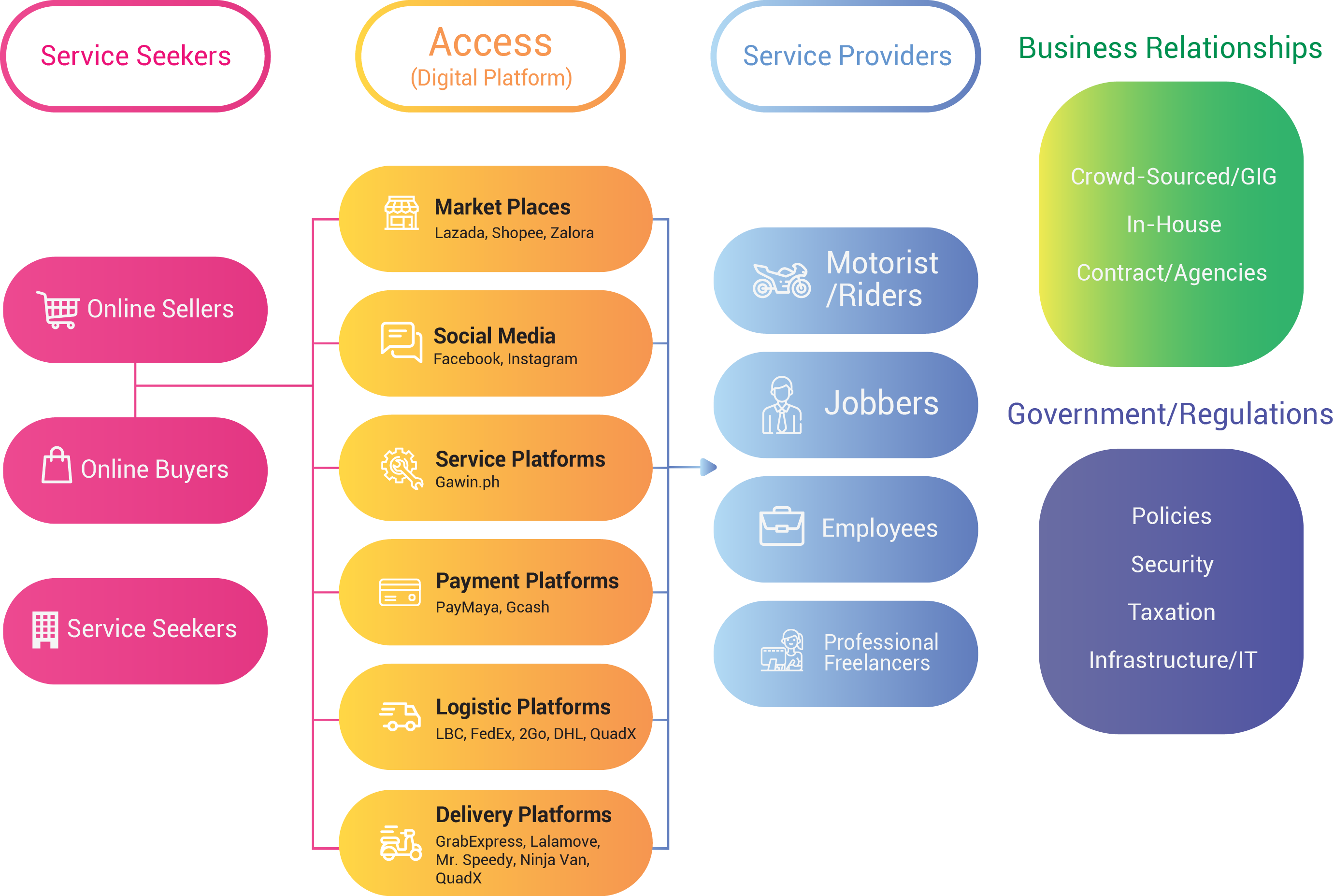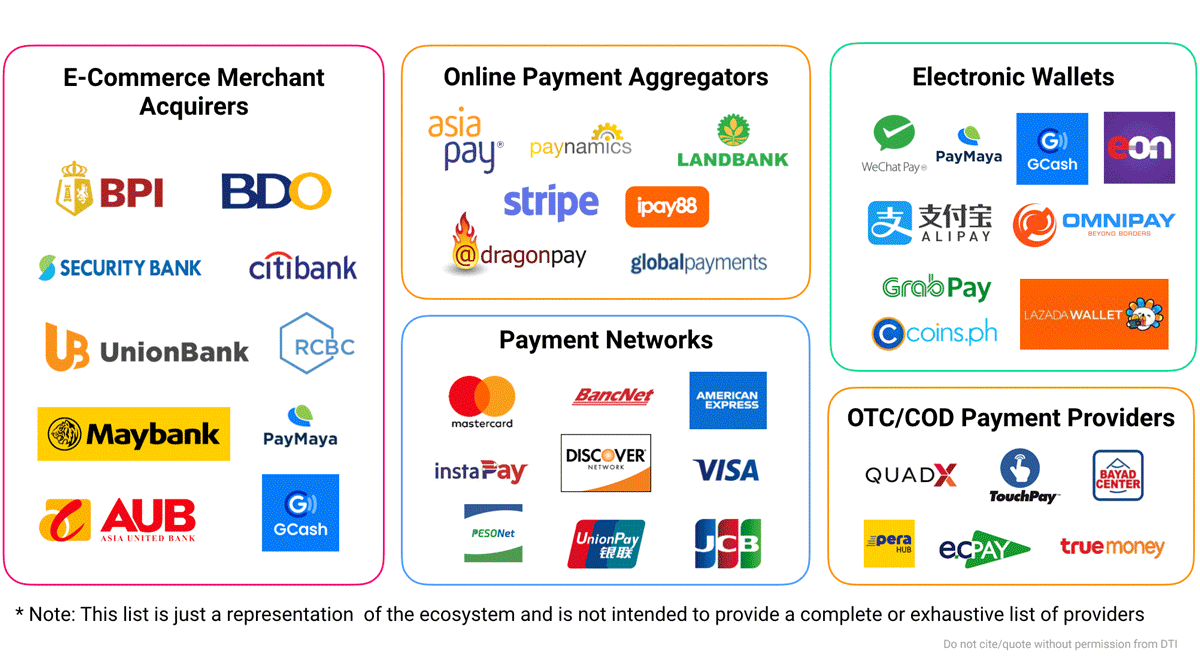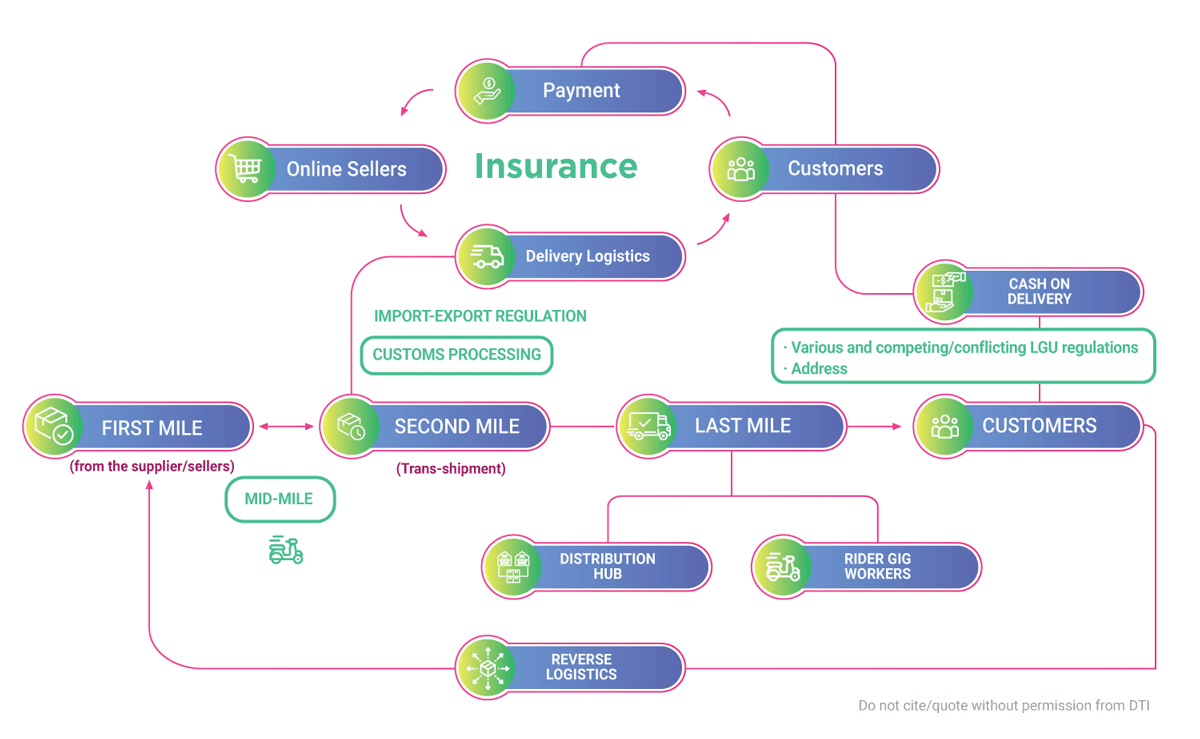Understanding e-Commerce in the Philippines
The Basics
E-commerce Defined
E-Commerce, simply defined, is commerce conducted through electronic means. However, throughout the decades, the way we define, appreciate, and use the word “electronic” has evolved heavily due to technological advancements. Consequently, different definitions, measures, and scopes of “e-Commerce” have emerged.
Various definitions of e-Commerce are recognized by different organizations, but for this roadmap, the Philippine Statistics Authority (PSA) definition, adopted from the Organisation for Economic Co-operation and Development (OECD), is used:
“The sale of purchase of goods and services, whether between businesses, households, individuals, governments, and other public or private organizations, conducted over computer-mediated networks. The goods and services are ordered over those networks, but the payment and the ultimate delivery of the good or service may be conducted on or offline.”
Originally, OECD defined e-Commerce as:
“...the sale or purchase of goods or services, conducted over computer networks by methods specifically designed for the purpose of receiving or placing of orders.”
This PSA’s definition is likewise consistent with the broader definition of the World Trade Organization (WTO):
““...the production, distribution, marketing, sale, or delivery of goods and services via electronic means.”
Implicit in numerous descriptions of e-Commerce is the importance of network and interconnectivity. As an enabler, it encompasses, affects, and is affected by a multiplicity of industries, forming an ecosystem within which these interact.
Economics of e-Commerce
Without being perfectly efficient, e-Commerce is noticeably faster and cheaper than traditional economic transactions, as it lowers friction by reducing the cost of exchanging information. The reduction of information asymmetry and creation of mutual value then depends on the level of collaboration, complementarity, connectivity, and, ultimately, the ability of e-Commerce participants to exchange and make use of information available in the ecosystem.
Lowering Barriers for MSMEs
E-commerce provides massive opportunities for businesses, as it reduces the capital and fixed expenses needed to participate as a merchant. Marketing, logistics, and other overhead expenses are replaced by internet and platform fees. In exchange for platform fees, online merchants gain access to a larger market, without being limited by store hours and physical distance to the customer.
Traditional businesses would also have to account for production costs and the number of actual orders, as the fewer transactions there are, the higher the production cost. E-commerce, on the other hand, maintains equal transaction costs across the board and can manage operating costs in different areas, therefore reducing the cost of individual transactions. MSMEs can therefore leverage on easy market entry, lower operation costs, and high revenue potential.
e-Commerce Architecture
E-commerce architecture defines the players in the ecosystem. As the diagram shows, the basic foundation is having the proper infrastructure in place.
Infrastructure here refers to both hard and soft infrastructure. Hardware covers equipment such as computers, servers, routers, switches, telecommunication infrastructures, and many others to enable organizations to have any IT services.
Software enables organizations to make use of hardware to provide services or products. Typical software includes productivity applications, enterprise resource planning, customer relationship management, information and security management. Skill/Talent or human capital with the necessary know-how are crucial to the setup and operation of the company
Digital platforms and online retailers easily connect buyers and sellers. The OECD defines online platforms as a “digital service that facilitates interactions between two or more distinct but interdependent sets of users who interact through the service via the Internet.” There are different types of platforms, such as e-Commerce platforms or marketplaces, which are online sales channel open for all sellers for marketing their goods and services, and may or may not collect payment on seller’s behalf. Marketplaces shall be differentiated from online retailers which refer to single seller’s own online channel for marketing its goods and services that complements its brick and mortar retail business model and collect payment on its behalf.
Enablers make it easy for buyers to purchase and sellers to market.
- Access refers to those responsible for providing Fast and reliable internet that enables access to platforms for buyers and sellers, or Search engines such as Google that provide information access to buyers and sellers, or Social media channels such as Instagram provide product-offering access to buyers and sellers
- Payment gateways or financial technology (fintech) remove the hassle borne by cash on delivery. Financial intermediaries like banks provide Credit offerings via digital banking provide short term loans for buyers and sellers to commerce
- Logistics refer to service providers such as last mile delivery services, truckers, warehouses, and collection points that are crucial to fulfill the on-demand needs of goods and services. These new modes of delivery means include robots and drones.
- Training institutions are also integral in the ecosystem. For Buyers, consumer protection training helps to mitigate risks in the digital economy. While Sellers can benefit from doing business online training to facilitate onboarding by MSMEs
The end goal is to help sellers and buyers reach out to each other without hassle and constraints.
The Ecosystem

The e-Commerce ecosystem can be defined as a network of interconnected functions that comprise the full cycle of buying and selling of goods and services electronically. To have a better grasp of the ecosystem, one can think of the lifecycle of an online transaction which begins from the accessing of the internet, to processing of the order, up to delivery and post-transaction services thereby, determining the various industries and companies at work.
This roadmap simplifies the interrelationship between e-Commerce players through the diagram which shows the interaction of the players in the community.
Platforms
Platforms Ecosystems

Platforms are strategic actors that function beyond creating markets towards designing these – by controlling the information available, case of search, and cost of access for users. By providing users the ability to access a greater variety of information at a lower cost, protracted haggling is avoided and the velocity of transactions is made faster.
Despite this control, platforms’ value hinge on
1. Their ability to create and maintain networks of buyers and sellers, preserving a virtuous circle of benefits among various users;
2. Their capacity to increase/induce trust by building reputation systems with strong feedback incentives;
3. Their level of integration with payment and logistics systems to complete business transactions, and;
4. Their capability to gather, manage, and exchange information with other platforms and service providers.
Payment

Payment Ecosystem

With the rise of e-Commerce comes a transformation in the way money is exchanged prompting the development of a vibrant digital payment ecosystem.
Growth in B2C markets and digital SMEs require payment systems that cater to huge volumes of micropayments at low cost, necessitating a dematerialization of money, presently made possible through electronic/digital banking and digital payment systems. While these systems are in place, providing payment options that cater to the unbanked, underbanked, and less digital-savvy individuals is key to making e-Commerce more inclusive. At the forefront are e-wallet and OTC/COD payment providers that allow even the unbanked to participate in e-Commerce by owning wallets with no minimum deposit and paying with cash. From the seller side, there are online payment aggregators and payment gateways that allow small merchants to process and receive online payment, without owning bank accounts.
Banks also play a critical role, especially with the digitization of B2B transactions. Some innovative banks are moving towards using open banking systems that allow them to work directly with platforms and third-party developers, paving the way towards a more collaborative approach to financial innovation.
Logistics
Logistics System

Supply chain management is an important back-end component of e-Commerce, with multiple merchants relying on third-party logistics providers to store and ship their products. Oftentimes, online marketplaces invest in warehouses, distribution centers, and sophisticated supply chain and logistics processes to satisfy the increasingly competitive demands of consumers.
Technology also plays an important role in improving logistics efficiency while giving customers more control over the delivery process. With it, marketplaces can:
- Synchronize the front and back-end of online retail,
- Reduce process redundancies through automation software and real-time data sharing, and
- Provide multiple shipping options for last-mile deliveries with the help of transport-focused platforms.
With further integration and collaboration between different platforms, logistics innovators can take advantage of data on customer purchase trends and preferences to be more strategic in resource allocation.
Intermediaries
Intermediaries are enablers or providers of e-Commerce related products and services that provide platforms with ancillary tools to better connect to users. These include email companies, digital marketing firms, and similar providers. Intermediaries or enablers make it easy for buyers to purchase and sellers to market. Whether they provide easier access to fast and reliable internet that enables access to platforms for buyers and sellers, or search engines that provide information access to buyers and sellers, or social media channels that provide product-offering access to buyers and sellers, training institutions that enable upskilling or reskilling, intermediaries facilitate.
Government
